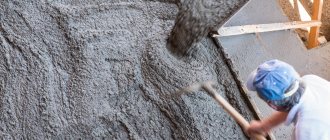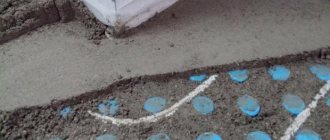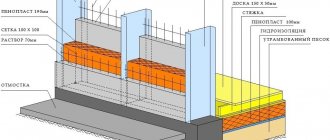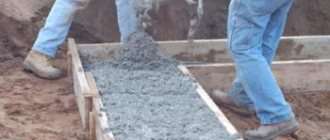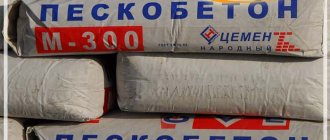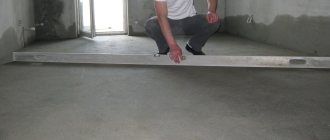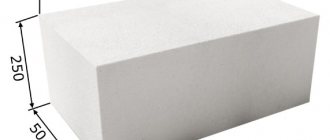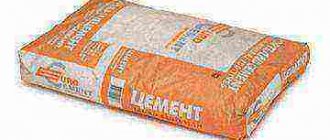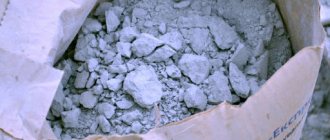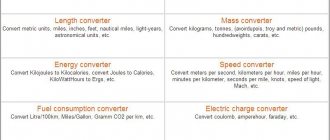Technical characteristics of sand concrete M300
The world of construction products is overflowing with a variety of materials, and is constantly updated with new types. Dry compounds containing cement, clay and sand are extremely popular. They are convenient to use, they make work easier, and improve the quality of the actions performed.
Sand concrete m300 is a new self-leveling mortar, the composition of which promotes rapid hardening. It appeared on the market relatively recently, but is already in high demand. Compared to concrete it has a number of advantages:
- no shrinkage;
- speed of hardening;
- frost-resistant.
Scope of use
The use of sand concrete when laying the foundation.
The versatility of use and practicality of the concrete mixture allows it to cover almost all construction. Sand concrete m300 is an excellent solution for the construction of reliable buildings, for external and internal work. The use of mortar simplifies the construction of outbuildings, residential buildings, and large construction buildings. Sand concrete m300 is widely used when pouring the base, when screeding floors, for caulking seams, and adjusting vertical and horizontal planes.
Self-leveling sand concrete mixture M300 is a valuable material for emergency, restoration and other work where instant hardening of the material is required. Due to its resistance to external factors, curbs and paving slabs are poured from the mixture.
Return to contents
Material structure
Manufacturers take the selection of proportions seriously, using the latest technologies and developments in material compositions. It is better to maintain the correct ratio, because otherwise it is difficult to get the expected result. Deviation from the correct ratio of components negatively affects the frost resistance, strength and water resistance of concrete. Sand concrete M300 is produced in dry mixtures, sometimes in the form of blocks.
The mixture contains three components: cement, sand and additives. Let's look at the components in more detail.
- Portland cement. A binder formed by grinding gypsum and clinker. First of all, clinker is crushed, then gradually added to gypsum and the desired composition is obtained. For one ton of finished material, 200-250 kg of Portland cement is used.
- Sand. Ordinary clean river sand is suitable. It is cleaned of stones, clay and other unwanted components. But it is better to buy a construction one, it is not only clean, but also corresponds to the required size up to 0.5 mm. The possibility of using sand concrete for various construction purposes is provided by the addition of coarse sand from 3 to 5 mm, sometimes it is replaced with granite chips.
- Supplements Plasticizers, anti-corrosion components, etc. help make M300 sand concrete better and provide the mixture with additional properties. 800 kg are allocated for all dry components, except cement, per ton of finished product.
According to technical indicators, ready-made sand concrete M300 is divided into three types:
- fine-grained, used for adjusting joints and external plaster;
- medium-fraction, used for the manufacture of screeds, paving slabs, poured floors;
- coarse-grained, suitable for pouring foundations.
Return to contents
Material consumption for the foundation
When working with sand concrete, it is important to correctly calculate the material consumption. Its quantity is influenced by the area of work performed and instructions for use. M300 is considered a universal remedy. It is used in any construction work: monolith, foundation, plastering, etc.
We take into account the consumption per 1m3:
- for pouring, a cubic meter will require 1.50 - 1.70 tons of dry compound;
- approximately 30 bags weighing 50 kg will be needed;
- the total material consumption can be calculated by knowing the working area.
Return to contents
Cost of screed
Calculation of sand concrete consumption for screed.
When pouring a screed, the calculation is based on area. Costs per 1m2:
- room area;
- screed height in m, if measurements are in cm, convert to m;
- the coefficient is 2 (for 1 m2 of ready-made solution there are 2 tons of dry mixture).
For example, the cost of pouring one square meter will be 18-20 kg, in a layer of one centimeter. It turns out that if the building area is 50 m2, the height of the screed is 7 cm, then to complete the work you will need 20 per 7 = 140 kg of dry composition. In real life, the height of the screed throughout the entire room will not be the same, because it is made to level the plane. It is better to measure the height over the entire area and make average calculations of concrete use.
Return to contents
Average proportions
Concrete proportions - the ratio of all components: cement, sand, crushed stone. Depending on the class of cement, the proportions are 1:3:5 or 1:2:4. It is worth considering that work with such a composition should take into account the density and size of sand, crushed stone, and cement. Consider the temperature at which work is carried out.
The final result is influenced by the initial surface preparation. The base is thoroughly cleaned, and only after removal of contaminants is M300 sand concrete applied. And remember that the concrete solution has its own lifespan, during which it completely gives up its properties. It is important to observe correct storage and transportation conditions.
In the construction world, sand concrete has a special place. Compared with concrete, you might think that its use is not economically profitable. However, experienced craftsmen recognize the advisability of using the material for external and internal work. By choosing it for work, you will get the best end result.
kladembeton.ru
Do-it-yourself sand concrete production
Sand concrete is a universal material that is used in most construction work during the construction of buildings and landscaping; the production of sand concrete is not complicated, the ingredients are available, so you can make the solution at home.
Sand concrete composition:
- Portland cement with grade from M300;
- Cleaned sand;
- Clean cold water;
- Plasticizers.
Special additives are used in production upon request; they provide the mass with additional properties.
The composition of the material may not be multicomponent, but despite this it has many positive properties.
Advantages of sand concrete:
- Good strength indicators
- Durability;
- Resistance to temperature changes and frost;
- Waterproof;
- No shrinkage.
Sand concrete is a practical material, used at various stages of work in the construction of low-rise buildings, when performing fundamental and installation work.
Builders distinguish one type of sand concrete – sand concrete M300. This type of material combines all the necessary qualities and is in an affordable price category. In addition, the technology for producing sand concrete is quite simple and allows, subject to compliance with the standards, to make a solution of M300 sand concrete with your own hands.
?
Scope of application of sand concrete M300:
- Making the foundation of the building;
- Concreting of staircases;
- Pouring the floor;
- Surface plastering;
- Sealing of tile and interblock joints;
- As a mortar for laying bricks and blocks;
- Filling the blind area;
- Laying pedestrian paths and sidewalks;
- Production of paving slabs and curbs;
- Production of sand concrete slabs and blocks;
- Concreting of various elements;
- Pouring reinforced concrete structures.
Sand concrete is a modern alternative to conventional concrete. Sand concrete is durable, lightweight, which has a beneficial effect on the foundation, economical and accessible to the masses. Products made from sand concrete are in great demand, as the material does not require special care and is easy to work with.
Let's take a closer look at the technology for making sand concrete and its composition, and also learn how to make sand concrete with your own hands.
Components of sand concrete
Sand concrete consists of three components - cement, sand and water. But despite this, every manufacturer of building materials is trying to develop a recipe for a material that will be more advanced than that of its competitors.
To do this, special components are added to the composition or the proportions of the material are changed. Special additives give the solution new qualities and increase the technological performance of concrete. The result is types of sand concrete that are used in different areas of construction - from laying bricks to pouring sidewalks.
You can make sand concrete yourself, the main thing is to purchase high-quality materials and follow the instructions.
Plasticizers
To improve the performance of the material, manufacturers often use various special additives; this applies to many types of building materials, including the production of M300 sand concrete.
They impart new properties, for example, resistance to mold and mildew, water resistance, frost resistance, etc. this allows the material to be used in various conditions - work at sub-zero temperatures, use in places with high humidity.
Plasticizers also significantly increase the strength, density and durability of the product and expand the scope of application. When making mixtures, you can use several types of additives; the main thing is to study the instructions first.
Cement-sand mixture brand M300
Sand concrete brand M300 is the most versatile ready-made cement-sand mixture of all those available for sale (one of the popular brands is described in the article Cement-sand mixture M300 Stone Flower). Representing an ordinary mortar for masonry and screed, it is successfully used both as high-strength plaster and as concrete. By introducing various additives, this material can be used as a basis for any cement composition needed at a construction site.
It differs from manually prepared CPS in the absence of shrinkage during hardening, characteristics guaranteed by the manufacturer. Making a solution that is pre-mixed in dry form is an order of magnitude easier than preparing the composition yourself from individual components. In addition, ready-mixed mixtures are less susceptible to caking and loss of strength over time than bagged cement. The advantages also include high plasticity, mobility, which facilitates work, and low water permeability.
The composition of high-quality sand concrete M300 includes:
- Portland cement grade M500 - about 25% of weight;
- fractionated sand, granite screenings, crushed stone chips 1-5 mm - about 75%;
- mineral additives (plasticizers, antifreeze, hydrophobic, and so on), fiberglass - optional, depending on the purpose of the mixture and the required characteristics.
Typically, the composition includes filler of two fractions - coarse screenings or crumbs (4 - 8 mm), and medium-grained quartz sand (0.8 - 2 mm). This allows you to achieve maximum strength and non-shrinkage with minimal binder costs. In cheaper materials, washed sand 1 - 5 mm is used.
Specifications
1. Brand compressive strength - sand concrete must withstand a pressure of 30 MPa a month after hardening; testing takes place in the laboratory when setting up dosing equipment. The presence of fine fractions and dust in construction sand, the approximate nature of dosing, and the use of compacted cement do not allow achieving the same guaranteed results when making CSP independently.
2. Maximum filler fraction - determines the main purpose of the mixture. Gravel 5 - 8 mm is taken when casting reinforced concrete structures, slabs and blocks, screenings 2 - 5 mm are used for screeding and the production of concrete products (curbs, paving slabs, Euro fences). There are types with especially fine grains of filler, designed for decorative and plastering work.
3. Water permeability is practically zero; after gaining strength, the remaining moisture in the material is less than 1%. Special additives help achieve even lower values acceptable for underground and underwater structures.
4. Frost resistance - the number of freeze-thaw cycles before the onset of destructive processes. Approximately, it can be taken as a period of impeccable service in years in the central zone and northern regions of Russia. Typical parameters are F35-F50.
5. Water holding capacity is an important characteristic for installation work. Severe loss of water from the solution leads to the formation of cracks and loss of strength. In high-quality mixtures, values of 95% and higher are achieved.
6. Range of operating temperatures - the compositions are designed for installation at temperatures of 5 - 30 degrees; with winter options, you can work effectively at 5 degrees below zero.
7. Setting time. From mixing to the start of the cement hydration process - 2 hours, but the value can vary within very wide limits under the influence of gypsum additives, low or high temperature, and constant stirring.
Sand concrete consumption
The ratio of components in the concrete mixture is selected in such a way that small filler particles evenly fill the space between large ones, therefore the density and consumption of the material are slightly higher than for conventional CFRP. In order to take into account costs at the planning stage, it is necessary to calculate the total volume of concrete poured depending on the type of work:
For casting reinforced concrete structures and monolithic walls, standard geometric formulas are used without taking into account reinforcement.
- Technological consumption rates are used for masonry.
- For plastering and pouring floors, calculate the total area of the treated surface and the average thickness of the mortar layer. The average distance from the base to the markings (beacons) is determined by measuring in several places along the entire plane.
On the packaging of the purchased mixture, costs are indicated in the format “sand concrete consumption per 1 m2, taking into account a layer thickness of 1 cm,” the usual values are 18-22 kg. The consumption per 1 m3 of solution can be obtained by multiplying the specified characteristic by 100.
Where is it used?
The main purpose is to create a high-strength, wear-resistant floor screed for further use without additional coating. Its widespread use is for the restoration of partially crumbled or cracked reinforced concrete structures, the manufacture of concrete products, and paving slabs. DSP is suitable for masonry or plaster mortar; for this, choose a type of material with no grains larger than 4 and 2 mm, respectively. It is easy to make expanded clay concrete or M200 from the finished mixture by adding expanded clay or crushed stone 1 to 1 (in volumes of dry material).
Precise guidance on the ratio of water and dry mixture, allowable working time and setting time is included with the product, and may vary depending on the composition. Average indicators are 1.5-2 liters of water per 10 kg, 1-2 hours to work with the solution, 1-2 days for hardening, a month to gain full strength. Excess water causes shrinkage, cracks and reduced performance.
Purchase costs
When trying to save on building materials, you need to consider the following factors:
1. The vast majority of brands of sand concrete are supplied exclusively in bags weighing 25 - 50 kg, rare offers of goods in MKR are unprofitable in price, and when purchasing nameless mixtures in bulk there are no guarantees of quality.
2. The greater the weight of the bag and the more inconvenient the unloading, the cheaper the purchase will be. Cost savings can reach 10-20%.
3. By buying in bulk, you will be able to reduce costs by 5–15%, but do not forget that the shelf life of this material does not exceed six months. You will need a dry, spacious room for pallets.
4. When choosing a supplier, first of all you need to find out the delivery price - an unsuccessful warehouse location can increase total costs by 20 - 50%.
5. Before you buy a product that stands out for its particularly low price, you should read reviews and customer reviews. Perhaps its technical characteristics are insufficient to perform the assigned tasks or do not correspond to the declared ones.
The cost of sand concrete M300 in Moscow excluding delivery:
| Name of dry mixture | Bag weight, kg | Cost of the bag, rubles | Price per ton, rubles |
| Stone flower M300 | 25 | 90 | 3600 |
| 40 | 120 | 3000 | |
| 50 | 145 | 2900 | |
| LUIX M300 Roussean | 40 | 130 | 3250 |
| Stock M300 Kreptsem | 30 | 100 | 3300 |
| 40 | 130 | 3250 | |
| 50 | 155 | 3100 | |
| Sand concrete Etalon M300 | 40 | 110 | 2750 |
| TsPS Finstroy M300 | 40 | 105 | 2620 |
| 25 | 70 | 2800 | |
| Rusean M300 | 40 | 145 | 3620 |
For comparison: 1 ton of dry mixture, prepared independently from granite screenings, cement and ordinary sand, will cost approximately 1,500 - 1,700 rubles.
The most reputable manufacturers in Russia are and. Both suppliers have production in the Moscow region and warehouses with the possibility of rail and road delivery to any European city in Russia. The “Stone Flower” sand concrete is suitable for a thrifty customer with average needs, and the “Rusean” mixture is suitable for a demanding customer who is willing to pay a little extra for quality.
stroitel-list.ru
How many bags of cement are needed for 1 cubic meter of concrete?
Qualified construction specialists often advise making your own concrete mixture rather than purchasing batches of ready-made pouring composition. Since the key component is cementitious cement powder, the cement consumption per 1 m2 should be clearly calculated
3 manufactured concrete grades of a certain level. All calculations are carried out within the framework of a special construction scheme, taking into account a number of important factors.
Selection of concrete grades for foundations and general construction tasks
The preparation of concrete mixtures is based on the fact that the required amount of each structural component is combined in a viscous solution, the most important of which is a certain volume of branded cement powder. The hardened mass has a number of optimal physical and technical characteristics and operational properties (high level of strength and ultimate density, resistance to mechanical stress and negative manifestations of natural phenomena).
Before starting construction activities, it is necessary to correctly determine (based on the information below) which grade of concrete can be used in a particular process. The foundation of any structure (residential building or technical structure) must have certain properties to maintain it during long-term operation.
Based on the brand, the types of concrete must be used as follows:
- From M100 and M150 to M200 and M250. These are not foundation mixtures. It is impossible to achieve reliability from them, and therefore experts do not recommend including them in work with supporting parts of structures.
- M300 (350) - has optimal performance for foundation pouring in private buildings. At the same time, the cost of the binding powder required in preparing the mixture is optimal.
- When produced from M400 or M500 cement, the mixture is used in industrial buildings, as well as for the construction of special-purpose facilities.
The main task of the supporting part of any building is to ensure the durability of its “life activity” without destruction and reduction in quality indicators.
Calculation of the required amount of cement
In addition to cement, the structural composition of the concrete mixture should include clean water and purified sand of a certain fraction, crushed stone or gravel, as well as various additives that form a number of quality features. The proportions of the binder powder relative to the liquid, sand and crushed stone determine the grade of the mixture.
Various regulatory and technical acts contain information about what proportion of cement in kg should be per cubic meter of mixture. However, qualified builders often use simplified calculation schemes.
Arithmetic method
In private activities, builders are guided by the following formulas to find out how many bags of cement are in 1 cubic meter of concrete.
- Mixing the main components to obtain a meter of cubic concrete assumes a CPSC ratio of 1:3:5.
- Cubic meter of mixture - 1 million cubic meters. cm, which means that the ninth part contains approximately 111,111 cubic meters. cm.
- With a specific gravity of the binder powder of 3 g/cm3, we obtain its mass per cubic meter of mixture: 3*111111=333333 g (~333.3 kg).
If we consider that standard bags contain 50 kg of powder, then there are approximately 6.5 pieces per 1 cubic meter of mixture.
Arithmetic accuracy
However, in reality, this scheme is relevant when considering a bag of grade 100 cement. In other cases, the values indicated are approximate. It is recommended to calculate how much cement will go into a cubic meter of mixture with an accuracy of 1 kg (crushed stone - up to 5 kg).
As practice shows, to knead a 10-liter bucket you will need 15-17 kg of binding powder and crushed stone, as well as 14-15 kg of sand fraction. If the brand of the resulting mixture should be higher, then the portion of the powder poured out of the bag of cement becomes smaller. The following table contains the most popular brand matches.
| Based on M300 cement powder | Based on M400 cement powder | |||
| Brand identity of the mixture | M250 | M300 | M300 | M300 |
| Weight value (in kg) of cement | 340 | 300 | 350 | 300 |
Based on these data, you can calculate the number of bags of cement per 1 cubic meter of concrete, remembering that one bag contains 50 kg of powder.
It is not advisable to use the highest grade Portland cement M500, since it is intended for narrow-profile tasks. If the mixture is oversaturated with cement powder after the active phase, when the moisture has completely evaporated, the base will begin to crack, which will naturally lead to a decrease in its quality.
Attention! How many bags of cement are actually poured into concrete is a value that is subject to change up or down.
Dependence of cement powder consumption on related factors
You should know how many bags of cement are in one cube of concrete, focusing not only on mathematics and practical methods close to the “by eye” method. This depends on the following factors:
- the desired brand and how quickly the mixture should set;
- plasticity and mobility of the mixture;
- type of other fillers used during mixing.
In fact, you will need to evaluate all the materials included in the mixture. In this case, it will be clear how much concrete can be obtained from the existing powder material or how much cement a cube of concrete will contain after mixing.
Purchase of the required volume of powder and necessary building materials
The Group meets all consumer and technical requirements in its activities. Having looked at the calculation schemes and recommendations within the article, you can know what proportion of cement powder is in the mixture used when installing walls or pouring the foundation when a house is being built. Then go to the “Contacts” section to order high-quality building materials from the best manufacturers.
Having calculated how much powder building material is needed, leave a request or call (feedback works) to discuss the details of the purchase. Competent managers will answer any of your questions. In our activities, we fulfill our obligations and also unconditionally respect the rights of our clients. A detailed site map and product catalog will help you find out what of our products you can get for construction.
Thus, when working with AlfaCem, you will not only be able to buy the best building materials, but also easily take advantage of professional advice on how much cement 1 cubic meter of the mixture contains, provided that it is carried out under different initial parameters. We wish you success!
Estimated consumption of sand concrete m300 per 1m3
Large-scale construction involves calculating sand concrete in cubic norms. On average, the consumption of sand concrete m300 per 1 m3 is 1500 kg -1700 kg of dry mixture. These data are multiplied by the working area - the final amount of sand concrete is obtained.
Sand concrete m300 - composition and proportions
Physical, mechanical properties: mobility, strength, consistency, plasticity, cyclical freezing and defrosting depend on the composition of the dry sand concrete mixture. The more plasticizers, chemical additives and impurities it contains, the more resistant the solution will be to mechanical stress. 1/3 of the mixture is cement, 2/3 is sand, gravel, screenings.
Before starting work, the dry mixture is mixed with water to obtain the finished solution. The optimal composition of the proportion of sand concrete m300 looks like this: 1 kg of mixture to 170 ml of liquid, i.e. for 10 kg – 1.7 l. Since a volume of one cube requires 1700 kg of dry mixture, then for this weight you will need the following amount of water: (1700*1.7)/10 = 289 liters. The final mass of sand concrete required to fill 1 m3 is multiplied with the amount of liquid per 10 kg of mixture, then the resulting figure is divided by 10 kg. The proportion of 1m3 includes sand concrete m300 and water.
rusean.ru
What is sand concrete made of?
The characteristics of sand concrete m300 (composition, proportions 1 m³) are standardized by GOST 7473-94.
High-quality dry mixture contains:
- Portland cement PC500 D20/PTs400 D0;
- fractionated dry sand, with a combined composition of fractions (particle size 0.80-4.0 mm);
- other additives (frost-resistant, microsilica, fiberglass) are introduced at the discretion of the manufacturer.
Depending on the sand used, M300 grade material is used to carry out certain work:
Properties of sand concrete m300 technical specifications
Sand concrete is a modern building material composed of a certain amount of Portland cement, sand and other additives that are added to the composition. All dry construction mixtures are manufactured in accordance with GOST 28013-98, which determines their technical characteristics, which will be discussed below.
Sand concrete M 300 technical characteristics
According to the current state standard, ready-made dry construction mixtures differ in the specified technical characteristics.
Compound
Any construction sand-concrete mixture is composed of the following components:
- Portland cement;
- sand;
- various additives - modifiers, plasticizers, etc.
For M300 grade materials, M500 Portland cement is used. In addition, the composition of the M300 mixture, the proportions of 1 m³ are as follows - 1/3 cement (acts as a binder) + 2/3 sand (filler).
The introduction of coarse sand into the composition allows the material to obtain a more rigid spatial structure, which is appropriate when conducting foundation work
Frost resistance according to GOST
This parameter clearly shows the ability of the material to withstand alternate repeated thawing and freezing without significant deterioration in strength characteristics and visible signs of destruction. For M300 grade material, frost resistance is at least 50 cycles. This mixture can be used when working in unheated rooms, for example, garages.
Compressive strength
This property allows us to understand what ultimate strength a material has under the influence of dynamic and statistical loads, exceeding which leads to inevitable deformation and destruction.
It is capable of withstanding loads up to 30 MPa. A private builder should know that 1 MPa is 9.81 kg/cm², which is often rounded to 10.00. Thus, the compressive strength of M300 sand concrete corresponds to 300 kg/cm².
Temperature range for work
When conducting construction within the temperature range, strict implementation of all technological processes is observed. The recommended mode for styling is from +5 to +25°C. Very often the builder is forced to break this rule, but then it is recommended to introduce frost-resistant additives into the material, which helps to carry out work without compromising quality down to -15°C.
Adhesion
Simply put, this is the ability of coatings to interact with each other. Sand concrete M300 forms strong adhesion to the base layer, which is equal to 4.0 kg/cm². This is a fairly high figure for dry construction mixtures. In order for adhesion to be fully realized, manufacturers recommend preliminary preparation of the base on which the material will be laid.
Bulk density
This is the density of a material in an uncompacted state, which takes into account not only the volume of particles, but also the space that appears between them. In private construction, it is better to operate with bulk density; M300 sand concrete in a bag is in exactly this condition (bulk density 1500 kg/m³).
A fresh screed made of sand concrete with coarse sand is less susceptible to shrinkage. This property allows to minimize defects, cracks and deformations
Taking this into account, it is possible to relate the mass and volume of bulk material and draw up the appropriate proportions for construction. For example, with the specified density the volume of material will be 0.67 m³/t. In private construction, a bucket (10 l) is used as a measuring unit, which has a volume of 0.01 m³ and will mix about 15 kg of dry sand concrete.
Sand particle size
Manufacturers produce M300 sand concrete with different sand fractions. This determines the technology for using the working solution:
- small size – up to 2.0 mm – suitable for external plastering, sealing joints;
- medium – 2.0-2.2 mm – suitable for arranging screeds, tiles, borders, etc.;
- large - more than 2.2 mm - used for the construction of foundations and foundations.
Mixture consumption (sand concrete m300 consumption 1 m²)
This is a standard characteristic that shows the consumer what he expects to consume material for arranging a m² of surface, with a layer thickness of 1.00 cm. For M300 grade sand concrete, this figure varies depending on the manufacturer and is 17-30 kg/m². Accordingly, the lower the expense, the cheaper the work will cost.
In addition, when constructing foundations, an indicator often appears (for sand concrete M300) - consumption per 1 m³, which also varies between 1.5-1.7 t/m³.
Delamination
The characteristic shows the connectivity of the solution in the upper and lower parts. The material in question has a delamination rate of no more than 5.0%, which is a standard GOST indicator for this class of substances.
Among other characteristics, the color of the mixture is noted, which should be uniform gray; viability of the finished solution – 2-3 hours; and its humidity is 0.20%.
Some manufacturers indicate the recommended thickness of the layer to be laid. Usually it is in the range of 10-100 mm (Gosta sand concrete). This indicator deserves attention if floor screed or plastering is carried out. When implementing monolithic work, the mixture consumption will increase. In addition, for pouring the foundations, a sand and gravel cushion of at least 30.00 cm is installed.
The standard hardening time for the solution is 24 hours, the surface is completely ready after 28 days, which is typical for all concrete. When working with a material such as sand concrete M300, the instructions for use should become the main guide for the master.
If you mix expanded clay and sand concrete, you can get expanded clay concrete, which can become the basis for making blocks
Price and selection options
When choosing M300 sand concrete (see technical specifications, price), you should contact trusted manufacturers. There are many brands on the domestic market that have decent quality. For example, “Stone Flower” sand concrete, whose technical characteristics are not inferior to foreign analogues, can become a worthy choice. Sand concrete M300 “Rusean” has earned good reviews.
The average cost of one bag of the finished mixture is 170 rubles. This amount will have to be paid for 50.0 kg of sand concrete.
In conclusion, I would like to note that the introduction of high-grade material is not always advisable. If you plan to carry out internal plastering work, install a rough screed, seal cracks and seams, you can use M150 sand concrete, the technical characteristics of which fully satisfy the needs of such repair and construction work.
The practical use of sand concrete M-300 when pouring screed is shown in the video:
Books on the topic:
No comments yet
obetone.com
How many bags of sand concrete are there in a cube? Volume of solution from a bag of mixture 50 kg
So, we have found out how much material such as sand concrete will be needed to fill a foundation or screed. Its consumption is quite large, but in general, the use of this material in private housing construction seems appropriate.
Of course, when using this material, you must knead it correctly. It is best to perform this operation in the following sequence:.
The solution should be used within 2 hours. Water cannot be added to a ready-made solution. During the pouring process, it is recommended to periodically pierce the mixture with a stake, rod or shovel to remove air bubbles.
The drying time of the finished mixture is one day. You will be able to walk on the screed in a week. The formwork is removed from the foundation on the second day. Sand concrete gains its final strength after 28 days, that is, like ordinary concrete. Reinforcement is required when the screed thickness is more than 2 cm.
How is the number of components calculated?
For all of the listed brands of concrete composition, there are proportions of the components used that require compliance. In the process of practicing the preparation of different compositions, the exact weight ratios of the parts of the mixture were determined, which determine the properties of the artificial stone. The grade of concrete is determined by the amount of dry cement in the solution relative to crushed stone and sand. When choosing a binding component, the main characteristic that determines its strength is taken into account, namely: brand. The higher its value, the less material is wasted. Thus, Portland cement M200 and M300 is used for finishing work, and M400 and M500 are used for the construction of monolithic walls and foundations.
When mixing concrete mortar for the foundation, the optimal ratio of dry cement to sand and crushed stone is 1: 3: 5. To determine the exact proportions of building materials when making concrete, their detailed characteristics are necessary, for example, the sizes of stone fractions, the elastic modulus of sand, the freshness of the binder, as well as the features of the planned work. The calculation is carried out based on SNiP 82-02-95.
Construction specialists strongly recommend observing the following requirement when choosing cement: the grade of the binder component must exceed the same characteristics of the concrete mortar by 1.5-2 times. For example, M100 concrete corresponds to the M200 cement grade.
